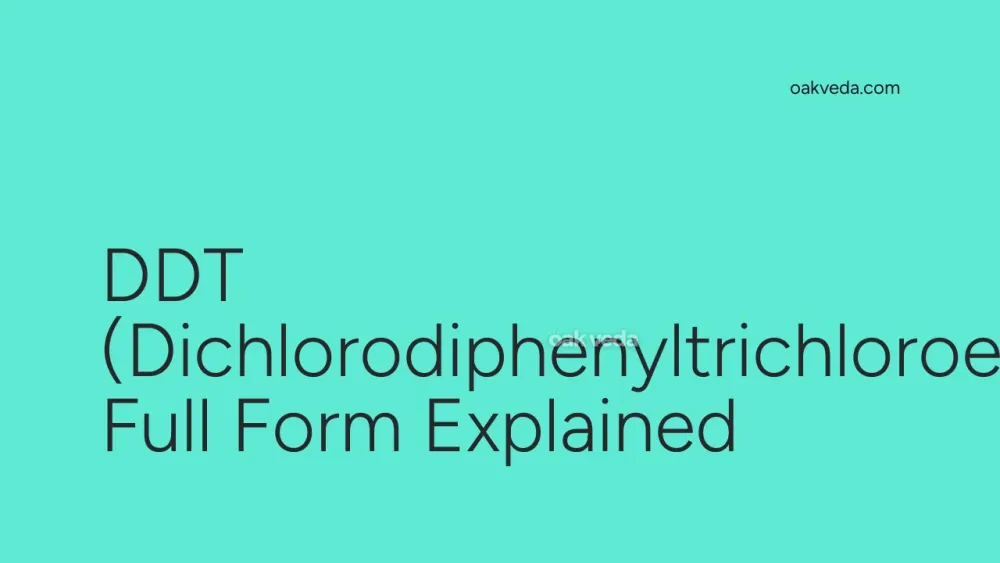
What is the Full Form of DDT?
DDT is an abbreviation for Dichlorodiphenyltrichloroethane. This chemical compound has played a significant role in agriculture and public health, but it has also been the subject of controversy due to its environmental impact and potential health risks.
What is Dichlorodiphenyltrichloroethane?
Dichlorodiphenyltrichloroethane, commonly known as DDT, is a synthetic organic compound used primarily as an insecticide. It belongs to the class of organochlorine pesticides and has been widely employed for controlling insects that spread diseases like malaria and typhus, as well as agricultural pests.
Origin and Development of DDT
The history of DDT dates back to the 19th century:
- 1874: DDT was first synthesized by Austrian chemist Othmar Zeidler.
- 1939: Swiss chemist Paul Hermann Müller discovered its insecticidal properties, later earning him the Nobel Prize in Physiology or Medicine in 1948.
- 1940s-1950s: DDT gained widespread use during World War II to combat insect-borne diseases among troops and civilians.
- 1962: Rachel Carson's book "Silent Spring" raised concerns about DDT's environmental impact.
- 1972: The United States Environmental Protection Agency (EPA) banned DDT for agricultural use in the country.
How does DDT work?
DDT functions as a potent neurotoxin in insects:
- Absorption: When insects come into contact with DDT, they absorb it through their exoskeletons.
- Nervous system disruption: DDT interferes with the normal function of sodium channels in nerve cells.
- Paralysis: This disruption leads to uncontrolled nerve firing, causing tremors and eventual paralysis.
- Death: The affected insects ultimately die due to the inability to move or feed.
Types of DDT
While DDT itself is a specific compound, there are related substances:
- p,p'-DDT: The primary isomer used in insecticides
- o,p'-DDT: A less common isomer with similar properties
- DDE and DDD: Breakdown products of DDT that persist in the environment
Functions of DDT
The primary functions of DDT include:
- Insect control: Eliminating disease-carrying insects like mosquitoes and lice
- Agricultural pest management: Protecting crops from insect damage
- Public health interventions: Controlling insect-borne diseases in endemic areas
Applications of DDT
Throughout its history, DDT has been applied in various fields:
- Agriculture: Crop protection against pests
- Public health: Malaria control programs, particularly in developing countries
- Household use: Indoor residual spraying for pest control
- Military operations: Protecting soldiers from insect-borne diseases
Features of DDT
DDT possesses several unique characteristics:
- Chemical formula: C14H9Cl5
- Physical properties: White, crystalline solid at room temperature
- Solubility: Highly soluble in fats and organic solvents, but insoluble in water
- Persistence: Long-lasting effects in the environment
- Broad-spectrum activity: Effective against a wide range of insects
Benefits of DDT
Despite controversies, DDT has provided significant benefits:
- Malaria control: Contributed to reducing malaria cases in many regions
- Crop yield improvement: Increased agricultural productivity by controlling pests
- Cost-effectiveness: Relatively inexpensive compared to alternative insecticides
- Long-lasting effects: Reduced frequency of application due to persistence
Limitations and Challenges of DDT
The use of DDT faces several challenges and limitations:
- Environmental persistence: DDT and its breakdown products can remain in the environment for decades.
- Bioaccumulation: Accumulates in the food chain, affecting non-target species.
- Ecological impact: Linked to eggshell thinning in birds and other wildlife effects.
- Human health concerns: Potential links to cancer, reproductive issues, and other health problems.
- Insecticide resistance: Some insect populations have developed resistance to DDT.
- Regulatory restrictions: Banned or severely restricted in many countries.
Future Developments in DDT Technology
While DDT use has declined globally, research continues in several areas:
- Safer alternatives: Development of less persistent and more targeted insecticides
- Integrated pest management: Combining multiple strategies to reduce reliance on chemical pesticides
- Genetic approaches: Exploring gene drive technologies for controlling disease vectors
- Environmental remediation: Techniques for cleaning up DDT-contaminated sites
FAQs on DDT Full Form
-
Is DDT still used today? While banned in many countries, DDT is still used in some regions for malaria control under WHO guidelines.
-
How long does DDT persist in the environment? DDT can persist in the environment for 2-15 years, with some breakdown products lasting even longer.
-
What are the main health risks associated with DDT exposure? Potential risks include cancer, reproductive problems, neurological issues, and developmental effects.
-
Why was DDT banned in the United States? The EPA banned DDT in 1972 due to its adverse environmental effects, particularly on wildlife.
-
Can DDT be detected in humans today? Yes, DDT and its breakdown products can still be detected in human blood and tissue samples worldwide.
In conclusion, the full form of DDT, Dichlorodiphenyltrichloroethane, represents a compound with a complex history. While it has played a crucial role in controlling insect-borne diseases and agricultural pests, its environmental persistence and potential health risks have led to widespread restrictions on its use. As we move forward, the focus remains on developing safer alternatives and addressing the long-term impacts of DDT use on global ecosystems and human health.
You may be interested in:

